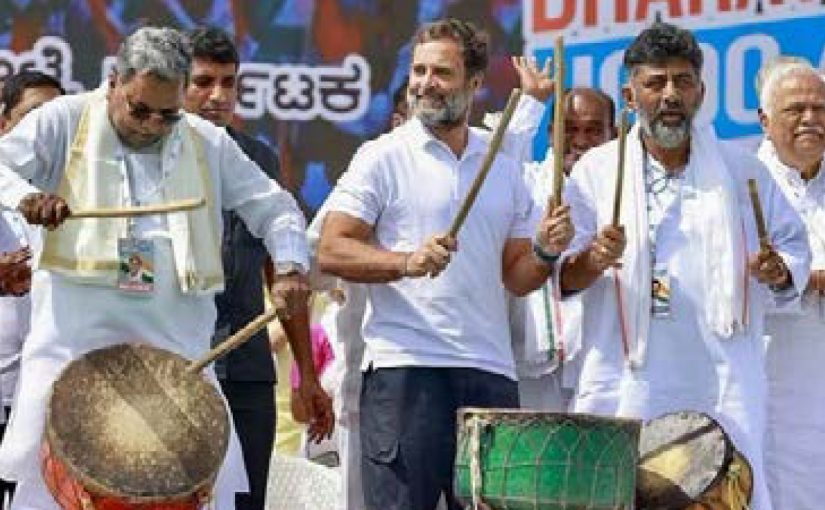By Asma Torgal
Victory has many fathers and defeat is an orphan. The last time BJP lost Karnataka after being in power for a full term was in 2013. Despite retaining 36% share, the BJP’s seat count went down from 104 in 2018 to 66. However, the current results suggest that the BJP was not able to convince the voters that it deserved a second term. The Congress, which hasn’t witnessed a thumping win since the 1989 elections, came to an end after the long-awaited results of the Karnataka general assembly elections 2023 results announced on May 13, 2023. The Indian National Congress (INC) emerged as the clear winner with a convincing victory, securing 135 seats and an overall vote share of 42.9%.
But what went wrong with BJP and right with Congress?
Polarising topics
The BJP’s religious polarization in Karnataka for the last three years was consistent. Issues like the hijab, halal meat, love jihad, and economic boycott of Muslims were aggressively raised by the BJP and Bajrang Dal; perhaps the idea was to divert people’s attention from price rise, corruption, and unemployment.
The BJP government also went on to pass anti-conversion and anti-cow slaughter bills. They even promised to implement the Uniform Civil Code (UCC) and the National Register of Citizens (NRC). In the hope of consolidating Hindu votes, the Bommai Govt also scrapped the 4% quota and in the last few campaigns, PM Modi aggressively invoked the Bajrang Bali controversy after the Congress in its manifesto declared that if elected it would ban the Bajrang Dal. But the communal cauldron which was deliberately kept on the burner switched off, once the Congress campaign kick-started ignoring not-too-sentimental issues rather working on local issues.
Strong Leader
Former Chief Minister and one of the tallest leaders in Karnataka, BS Yediyurappa (prominent face of the Lingayat community since the 1980s) was visibly sidelined by the party during the entire election campaign. A few leaders got miffed with BJP, as the party denied tickets to former CM Jagadish Shettar and former deputy CM Laxman Savadi who then went ahead and joined the Congress. Basavaraj Bommai, on the other hand, couldn’t charm his presence as CM. He faced corruption charges, one of them was, Bommai’s posters pasted over the image of a QR code with the phrase ‘PayCM’ written above, which were put up across cities. This seems to have hit the right note with the voters alongside, dented the image of Bommai. The BJP strategy reinventing the party by replacing a senior leader with a dynamic one, did not preferably succeed.
Unlike the BJP, the Congress did not develop any second line of leadership in the state. The party has three leaders who are known statewide. DK Shivakumar was countering every move by the BJP on the same coin. Malikarjun Kharge and Siddaramaiah also proved to be the most charismatic crowd puller, far more than rival Bommai.
The Lingayat effect
Lingayat has a significant vote bank in Karnataka politics and has always played a crucial role in deciding the outcome of several elections. Lingayats have been the BJP’s biggest pillar of support in the state, however, this time it dint not go parallel way.
Lingayats, who make up 15-16% of the state’s population, cannot alone ensure a victory. The scrupulous pay to the Lingayat community by the BJP prompted the other comparatively weaker sections of the society (Backward Castes, Scheduled Castes, Scheduled Tribes and Muslims) to drift towards the Congress. Neither scrapping the 4% Muslim quota and adding to Lingayat and Vokkaligas community, reap much dividends for the saffron party. On the other hand, the few sections of Vokkaligas, who comprise 12-13%, preferred the Congress, which had D.K. Shivkumar (an influential leader of the same community).
Anti-incumbency stir
The major bump for the BJP’s defeat in Karnataka has also been the inability to find a counter to the anti-incumbency stir.
BJP made several promises during the election campaign, but Karnataka voters held dissatisfied with the party for largely failing to deliver what it promised.
The Congress, on the contrary, tailored its campaign around local, civic issues and cornered the incumbent government over poor implementation of welfare schemes. It gave five major guarantees of Rs 2,000 per month to every woman head of a family; free bus passes for all women; Rs 3,000 for graduates and Rs 1,500 for diploma holders as unemployment monthly payment; 10 kilos of rice; and 200 units of free power to households if came to power.
Since the campaign in the state began, it witnessed many controversies from Mallikarjun Kharge’s ‘poisonous snake’ remarks, to Amul vs Nandini and other micro issues, made it more appealing among the people. But what worked for the Congress in Karnataka was a perfect combination of several factors that helped it secure an upper hand over the BJP.
In the end, it was do or die battle for Congress in Karnataka. This assembly election win was massive for the Congress which was on the back foot after the two humiliating defeats in the 2014 and 2019 Lok Sabha elections as well as crushing debacles in a string of assembly elections in different parts of the country over the last many years.
To conclude, in Karnataka assembly polls, it is clear that voters can’t be taken for granted. People can’t be fooled by religious slogans. A non-performing government can’t hide behind religion just to divert the real issues. Indeed! Karnataka voters have imparted important lessons to India’s political class.
